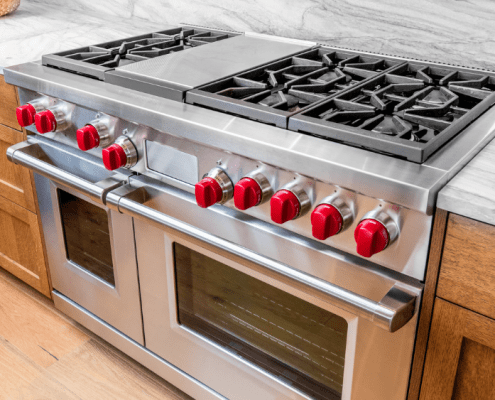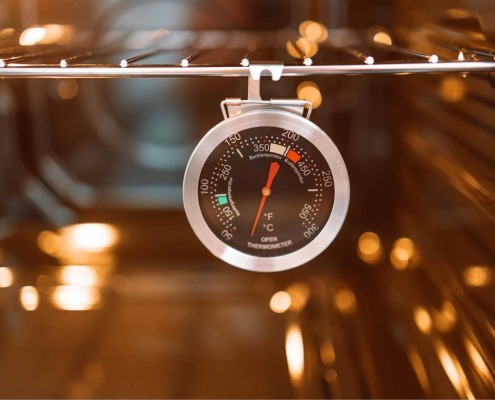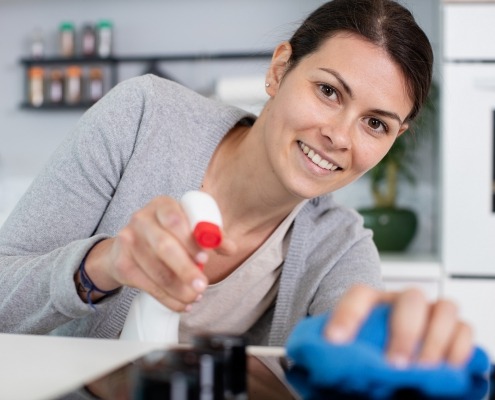How to maximize oven space and cook multiple dishes at once
Steven E / Tuesday April 22, 2025
Cooking multiple dishes simultaneously can be a challenge, especially when oven space is limited. However, with the right strategies and techniques, you can maximize your oven’s capacity and successfully cook multiple dishes at once. In this article, we will explore various tips and tricks to help you make the most of your oven space. From utilizing racks efficiently to adjusting cooking times and temperatures, we’ll provide you with practical advice on how to optimize your oven’s capabilities and prepare multiple dishes with ease. Say goodbye to the hassle of juggling cooking times and hello to efficient and stress-free meal preparation. Let’s dive into the world of maximizing oven space and unlock the potential for cooking multiple delicious dishes simultaneously!
If you find out that you need any replacement parts for your oven while you’re troubleshooting, you can enter your model number at AppliancePartsPros.com to order them. Most orders arrive in just two business days, and we have thousands of free guides to show you how to install your new parts.
The information in this article may not apply to your specific appliance model. We recommend consulting your manufacturer’s documentation or contact us with any questions.
Planning and preparation
Efficient oven use starts long before you turn the oven on. Careful planning and preparation are the foundation of successfully cooking multiple dishes at once. Here’s how to get started:
Create a detailed menu with cooking times and temperatures
When preparing a multi-course meal, especially during holidays or special gatherings, having a meticulously planned menu with precise cooking times and temperatures is helpful.
- List all the dishes you plan to prepare, including appetizers, mains, sides, and desserts.
- Note the required oven temperature and cooking time for each dish.
- Group dishes with similar temperature and time requirements together to streamline the cooking process.
Identify which dishes can be prepared or partially cooked in advance
Efficiency in the kitchen isn’t just about what happens on the day of your meal—it’s about how you manage your time leading up to it. One of the keys to successfully cooking multiple dishes is identifying which ones can be prepared or partially cooked in advance.
- Make a checklist of tasks that can be completed before the cooking day, such as chopping vegetables, marinating meats, or assembling casseroles.
- Prepping ingredients and partially cooking certain dishes in advance can free up valuable oven space on the big day.
- Create a schedule that outlines when you will complete each pre-cooking task. Consider the cooking time needed for each dish on the day of your meal.
Determine the cooking order based on temperature requirements
When preparing multiple dishes, carefully plan the order in which you cook each item based on their temperature requirements. This ensures that all dishes are ready to be served at the same time.
- Start by preheating the oven to the temperature required for the dish that needs the highest heat.
- Arrange the rest of your dishes in order of decreasing temperature, allowing the oven to gradually cool as you cook each one.
- Consider a brief temperature increase at the end to ensure all dishes are perfectly cooked.
Organizing your oven
Maximizing oven space and cooking multiple dishes simultaneously requires careful organization and smart use of your oven’s interior. Here are some tips for arranging your oven:
- Adjust the oven racks to different heights to create space for dishes of varying sizes and heights.
- Place the larger and taller dishes towards the back of the oven to prevent them from blocking heat and airflow to smaller dishes in front.
- Utilize oven bags for some dishes to contain moisture and reduce the risk of spillage or cross-contamination.
- Opt for sturdy, non-warping bakeware that conducts heat evenly for consistent results.
- Ensure your oven is fully preheated to the desired temperature before placing any dishes inside.
- Preheating contributes to even cooking, better browning, and reduced cooking times for your dishes.
Multi-level cooking techniques
To make the most of your oven space and successfully cook multiple dishes at once, you’ll need to employ multi-level cooking techniques. These methods allow you to use the entire oven for various dishes. Here’s how to do it:
- Utilize the different levels of your oven racks to cook multiple dishes simultaneously. Ensure that each dish has enough space to allow hot air to circulate evenly.
- Be cautious with dishes that release a lot of steam, as they may affect dishes above them. Use foil to create a barrier if needed.
- Divide your oven into temperature zones by placing dishes with similar cooking temperatures together.
- Start with dishes that require the highest temperature at the bottom, then work your way up to dishes with lower temperature requirements.
- Adjust the oven’s temperature as you remove dishes and add new ones to maintain the right heat levels.
- Periodically rotate dishes on the oven racks to ensure even cooking. For example, turn dishes 180 degrees or swap the positions of upper and lower racks.
- Use caution when opening the oven, as it can cause temperature fluctuations. Do so only when necessary and quickly.
- Keep an oven thermometer inside to monitor temperature accuracy throughout the cooking process.
Timing and monitoring
As you cook multiple dishes in your oven, precise timing and continuous monitoring are essential to avoid overcooking or undercooking. Here’s how to manage the timing and keep a watchful eye on your dishes:
- Use a combination of kitchen timers, smartphone alarms, and oven timer features to keep track of cooking times for each dish.
- Set timers to account for different cooking durations and stagger the completion times, allowing for a seamless meal.
- Label timers with the corresponding dish name to avoid confusion.
- Use the oven light and window to visually monitor the progress of your dishes without disrupting the oven’s temperature.
- Plan brief check-ins to avoid excessive heat loss, especially for dishes that require precise timing.
- Invest in an instant-read thermometer to check the internal temperature of meats, casseroles, and other dishes.
- Insert the thermometer into the thickest part of the dish to ensure it has reached the desired doneness.
- Keep in mind that different dishes may have varying ideal internal temperatures.
Recipe adaptations
Adapting recipes is a crucial aspect of successfully cooking multiple dishes in one oven. Not all dishes will fit perfectly into your cooking schedule, so you may need to modify recipes to suit the available oven space and timing. Here’s how to do it:
- Adjust cooking temperatures: If a recipe calls for a specific temperature that conflicts with your oven’s setup, consider adapting it to the oven’s current temperature zones.
- Alter cooking times: Modify the cooking time to fit within your timeline, taking into account the other dishes being prepared.
- Use smaller portions: For dishes like casseroles or gratins, make smaller individual portions to maximize oven space.
- Plan a menu with dishes that have similar oven temperature requirements. For instance, if you’re roasting a chicken, consider roasting vegetables alongside it.
- Pair dishes that can be cooked together without adversely affecting their flavors or textures.
- If multiple dishes require broiling or browning at the end of their cooking time, plan to finish them together.
- Utilize techniques like tenting with foil or adjusting the rack position to manage browning.
Resting and reheating
The process of cooking multiple dishes in your oven doesn’t end when they’re done cooking. Proper resting and reheating are important steps to ensure that your meal is served at its best. Here’s how to manage these aspects:
- Factor in resting time for dishes that benefit from it, such as roasted meats, casseroles, and baked goods.
- Resting allows flavors to meld, juices to redistribute, and dishes to achieve their ideal texture.
- Use insulated foil to tent dishes and keep them warm while they rest.
- Prioritize the dishes that need to be served hot, like roasted vegetables or certain sides.
- Use your oven’s warming feature, set to a low temperature, or utilize microwave or stovetop reheating for dishes that may have cooled during resting.
- Reheat dishes using a low temperature and, if possible, in an oven-safe container.
- Add a bit of moisture, such as broth or water, to prevent dryness when reheating.
- Use a food thermometer to ensure reheated dishes reach a safe serving temperature.
Troubleshooting and problem-solving
While cooking multiple dishes in one oven, unexpected issues may arise that require quick thinking and creative problem-solving. Being prepared to address common challenges will help you maintain control and ensure a successful meal. Here’s how to troubleshoot and solve problems:
- Uneven cooking: If some dishes are cooking faster or slower than expected, rotate their positions in the oven and adjust cooking times accordingly.
- Overcrowding: If you find that dishes are too close together, consider removing one temporarily, finishing it on the stovetop or in a microwave, and returning it to the oven when there’s more space.
- Flavor crossover: Prevent cross-contamination of flavors by using foil barriers or covers for particularly fragrant dishes.
- Be flexible with your cooking schedule and be prepared to make real-time adjustments to accommodate any unexpected issues.
- Monitor the progress of each dish and be ready to change the oven temperature, rearrange dishes, or adjust cooking times as needed.
Additional information
Thanks for reading! If you need replacement parts for any of your appliances, check out AppliancePartsPros.com, where you can enter your model number to find exactly what you’re looking for. Most orders arrive in two business days, and we have thousands of free resources to show you how to install your new parts.
You can also reach our award-winning customer service team at 1-877-477-7278, chat with a pro on our website and watch thousands of free video tutorials on our YouTube channel.
With nearly a decade of experience in providing top-notch customer service regarding appliance parts and repair, Steven enjoys sharing practical advice, troubleshooting tips, and interesting information to help readers stay informed.





